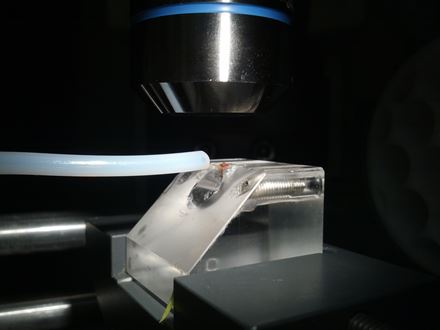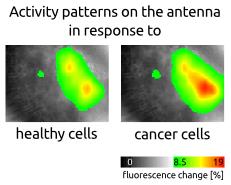Fruit flies can smell cancers
3 February 2014
Researchers from the University of Konstanz, Germany and the University La Sapienza in Rome, Italy, have recorded the antennae of fruit flies detecting odours given off by cancer cells. Not only could the fruit flies distinguish between healthy cells and cancer cells, they could also identify different cancers.
The team of biologists and electronic engineers used the fact that single odour molecules dock to receptor neurons in a fruit fly antenna, thus activating the neurons. The fruit flies used in the experiment were genetically modified so that their antenna neurons fluoresce when they are triggered. Different odorant molecules of the respective scent samples create different patterns of activated neurons. These were detected using an imaging technique developed by the researchers called in vivo calcium imaging.
In the experiment five different types of breast cancer cell lines were analysed, compared to healthy cells and clearly divergent patterns were generated.

The fruit fly sits on the podium in the middle
of the picture. Scents, eg of cancer cells, are emitted from the
tube on the left, which is directed towards the fly. Above, is the
lens of the microscope that is used for recording images of the
fly's antenna.
"What really is new and spectacular about this result is the combination of objective, specific and quantifiable laboratory results and the extremely high sensitivity of a living being that cannot be matched by electronic noses or gas chromatography", explains Konstanz-based neurobiologist and zoologist Professor Dr Giovanni Galizia.
"The high sensitivity of the natural olfactory receptors, paired with the quickness with which we can generate these test results, might lead to the development of a cheap, fast and highly-efficient pre-screening that can detect cancer cells well before we can discover them with the present diagnostic imaging techniques."

"As not only cancer cells can be distinguished from healthy cells, but also subgroups were discernible within the cancer cells, it seems that even different types of breast cancer cells can be differentiated via the antenna of Drosophila," explains Alja Lüdke, member of the research unit and researcher at the University of Konstanz.
The researchers call this a "first step towards electronic noses equipped with biological sensors, integrating artificial and biological olfaction."
Reference
Strauch M. More than apples and oranges. Detecting cancer with a fruit fly's antenna (2014). Scientific Reports 4, Article number: 3576. January 2014. doi:10.1038/srep03576
Harry Wood